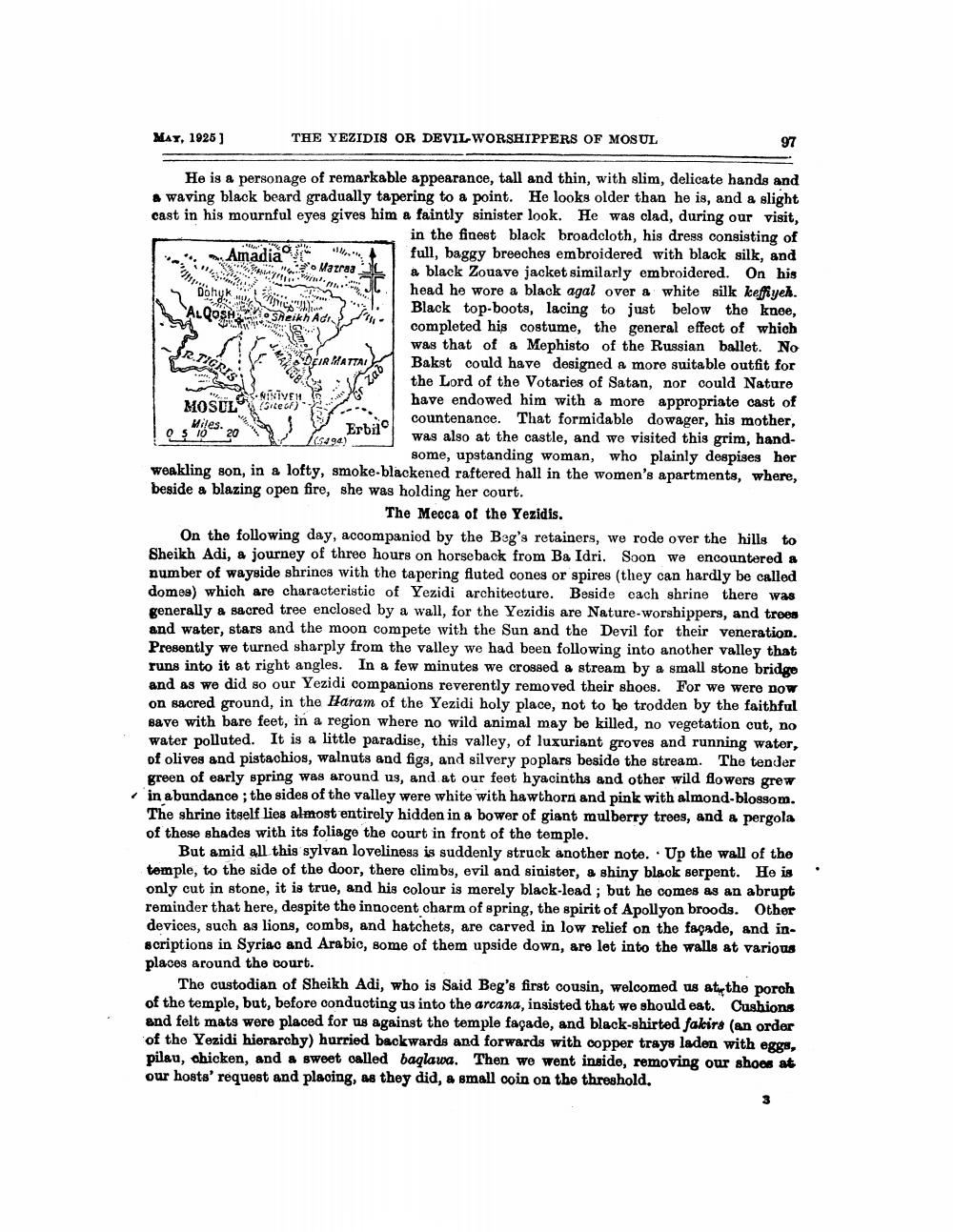________________
MAY, 1925]
He is a personage of remarkable appearance, tall and thin, with slim, delicate hands and a waving black beard gradually tapering to a point. He looks older than he is, and a slight cast in his mournful eyes gives him a faintly sinister look. He was clad, during our visit, in the finest black broadcloth, his dress consisting of full, baggy breeches embroidered with black silk, and a black Zouave jacket similarly embroidered. On his head he wore a black agal over a white silk keffiyeh. Black top-boots, lacing to just below the knee, completed his costume, the general effect of which was that of a Mephisto of the Russian ballet. No Bakst could have designed a more suitable outfit for the Lord of the Votaries of Satan, nor could Nature have endowed him with a more appropriate cast of countenance. That formidable dowager, his mother, was also at the castle, and we visited this grim, handsome, upstanding woman, who plainly despises her weakling son, in a lofty, smoke-blackened raftered hall in the women's apartments, where, beside a blazing open fire, she was holding her court.
The Mecca of the Yezidis.
On the following day, accompanied by the Beg's retainers, we rode over the hills to Sheikh Adi, a journey of three hours on horseback from Ba Idri. Soon we encountered a number of wayside shrines with the tapering fluted cones or spires (they can hardly be called domes) which are characteristic of Yezidi architecture. Beside each shrine there was generally a sacred tree enclosed by a wall, for the Yezidis are Nature-worshippers, and trees and water, stars and the moon compete with the Sun and the Devil for their veneration. Presently we turned sharply from the valley we had been following into another valley that runs into it at right angles. In a few minutes we crossed a stream by a small stone bridge and as we did so our Yezidi companions reverently removed their shoes. For we were now on sacred ground, in the Haram of the Yezidi holy place, not to be trodden by the faithful save with bare feet, in a region where no wild animal may be killed, no vegetation cut, no water polluted. It is a little paradise, this valley, of luxuriant groves and running water, of olives and pistachios, walnuts and figs, and silvery poplars beside the stream. The tender green of early spring was around us, and at our feet hyacinths and other wild flowers grew in abundance; the sides of the valley were white with hawthorn and pink with almond-blossom. The shrine itself lies almost entirely hidden in a bower of giant mulberry trees, and a pergola of these shades with its foliage the court in front of the temple.
Dohyk
ALQOSH
Amadia
R.TIGRIS
MOSUL
Miles. 05 10
20
THE YEZIDIS OR DEVIL-WORSHIPPERS OF MOSUL
O
J.MAKLUB
ne Sheikh Adr
Mazraa
NINTVEH (Site of)
DEIR MATTAL
Zab
Erbil
(5490)
97
But amid all this sylvan loveliness is suddenly struck another note. Up the wall of the temple, to the side of the door, there climbs, evil and sinister, a shiny black serpent. He is only cut in stone, it is true, and his colour is merely black-lead; but he comes as an abrupt reminder that here, despite the innocent charm of spring, the spirit of Apollyon broods. Other devices, such as lions, combs, and hatchets, are carved in low relief on the façade, and inscriptions in Syriac and Arabic, some of them upside down, are let into the walls at various places around the court.
The custodian of Sheikh Adi, who is Said Beg's first cousin, welcomed us at the porch of the temple, but, before conducting us into the arcana, insisted that we should eat. Cushions and felt mats were placed for us against the temple façade, and black-shirted fakirs (an order of the Yezidi hierarchy) hurried backwards and forwards with copper trays laden with eggs, pilau, chicken, and a sweet called baqlawa. Then we went inside, removing our shoes at our hosts' request and placing, as they did, a small coin on the threshold.
3




